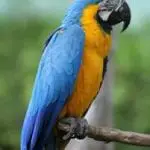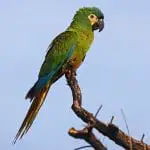Scientific Facts
| Common Name: | Blue-throated Macaw |
| Scientific Name: | Ara glaucogularis |
| Life Span: | Up to 35 years |
| Mass: | 750 grams |
| Length: | 85 cm |
| Habitat: | Grasslands, savannahs, and swamps |
| Country of Origin: | Bolivia |
Physical Description
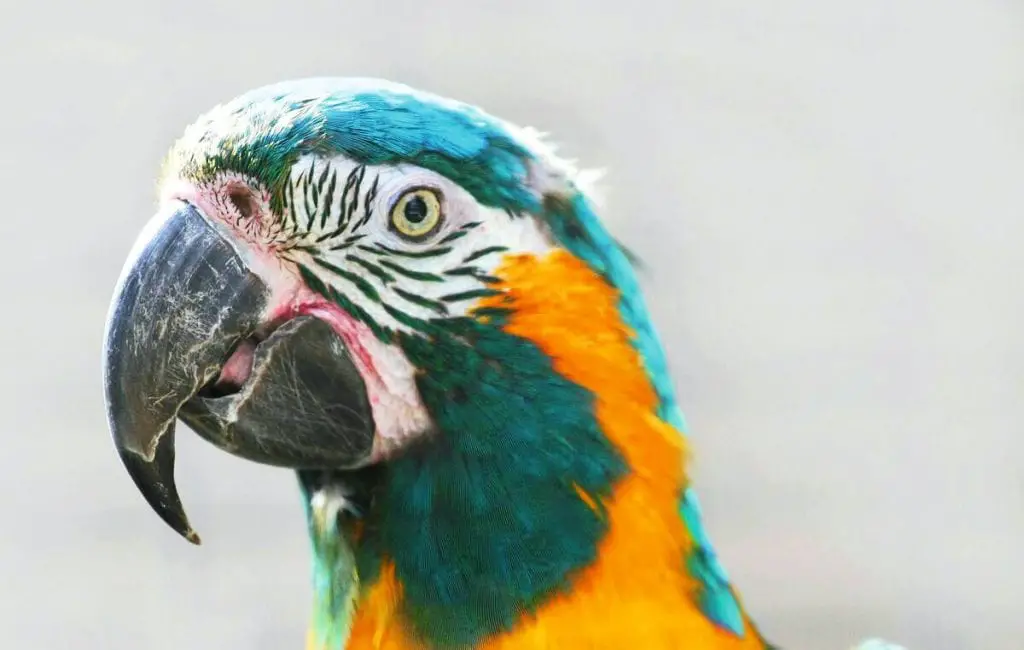
Blue-throated Macaws have very vivid coloration, and they have beautiful bright blue and turquoise feathers covering their back, their throats, the crown on their forehead, their back, the dorsal side of their wings, and their tail. There are also some golden feathers that grow like a stripe between their throat and crown on the side of their face and on the ventral side of their body, wings, and tail. On their face, there is also a sparsely feathered patch of skin near their beak that has 5 or 6 horizontal stripes of blue feathers which are unique for Blue-throated Macaws and can be used as their self-identification.
Adult Blue-throated Macaws weigh around 600 grams to 1,000 grams with a length of about 85 cm from their head down to their tails. Their wingspan, on the other hand, reaches about 3 feet or 0.9 meters. The male ones also tend to be a little bigger compared to the female ones.
When they are still newly hatched, the blue-throated macaws are entirely pink without any feathers. Juveniles are colored gray and get replaced with the beautiful colors as they age.
Conservation Status
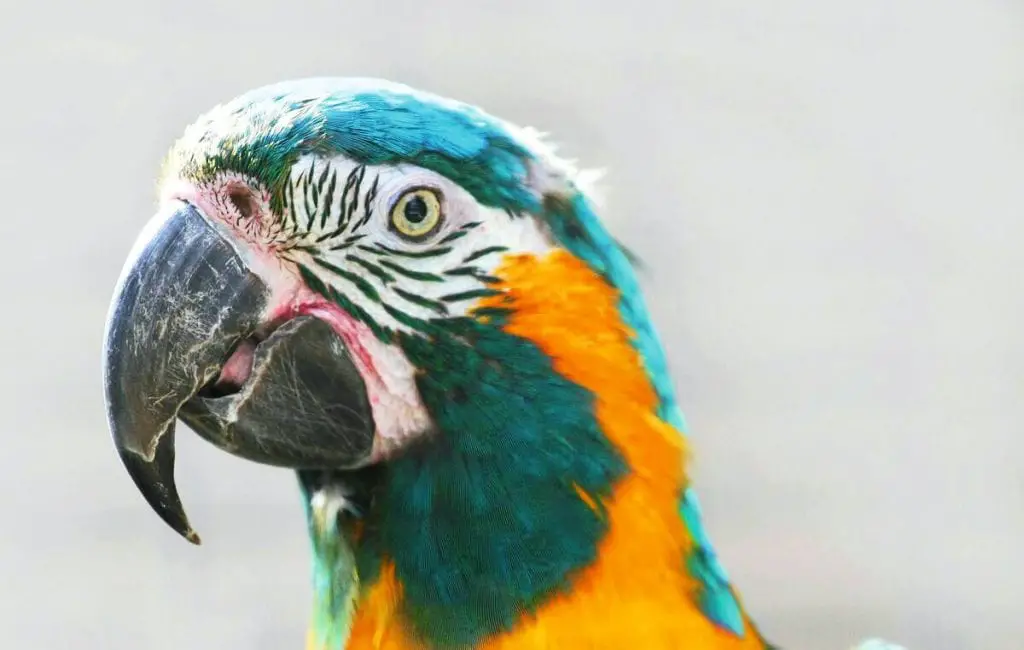
The blue-throated macaw is currently rated in the IUCN Red List as critically endangered. They are also listed in Appendix 1 of CITES. In Bolivia, trapping of blue-throated macaws is considered as illegal and punishable by the law. This is because the trapping for illegal trading and trafficking is the leading cause of why these birds are being endangered. Because these species are very rare, their selling has gone even higher, and the locals are motivated to trap them even more.
Because the Spix’s macaws went extinct in 2000, the blue-throated macaws are currently believed to be the rarest species of macaw in the entire world. With the current population in the wild estimated to be between 50 to 250 individuals, extreme conservation actions are necessary to keep the species alive. The World Parrot Trust is working alongside their employees, volunteers, and partners to work towards salvaging the dying population of the species.
Availability and Natural Habitat
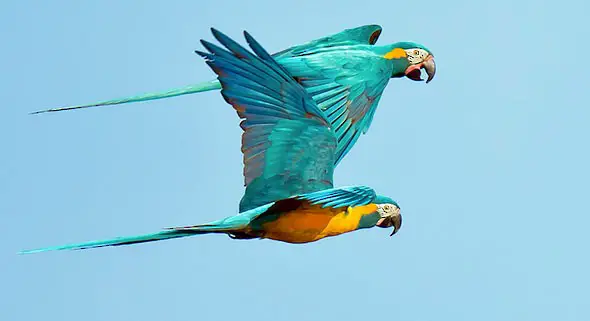
The Blue-throated Macaws are only found in the Bolivian Beni department, which is about 200 to 300 meters above sea level. They live in a geographical range of about 2,508 kilometers. They basically occupy two main sub-populations: first, the northwest of Trinidad, and the second one is the south of Trinidad.
These birds thrive in islands of trees and gallery forests that are surrounded by tropical savannahs. During seasonal rains from October up to May, the savannahs transform into grassy swamps. Also, most of the natural habitat of its birds are used for cattle ranching. However, these lands are unsuitable for cultivation, and altering their habitat for agricultural use does not occur.
Life Span
In captivity, blue-throated macaws have the ability to survive up to about 30 to 35 years, after which they start to exhibit signs of aging and acquiring age-related diseases begin to show. Very few blue-throated macaws in captivity live up to 50 years of age. Blue-throated macaws have not been studied very long in terms of their existence in the wild, and the extent of their life has yet to be discovered.
Behavior, Exercise, and Training
Video Source
Embed Code: <iframe width=”544″ height=”360″ src=”https://www.youtube.com/embed/3iYEkFDUoQI” frameborder=”0″ allow=”accelerometer; autoplay; encrypted-media; gyroscope; picture-in-picture” allowfullscreen></iframe>
Blue-throated macaws are social in nature as they are able to form partnerships and thrive while living in small communities. At one point, it has been seen that a community of 70 individuals has been living in harmony together. But, this is harder for blue-throated macaws because they are very rare and have a small-numbered population.
These blue-throated macaws also enjoy living, feeding, and nesting in the trees. Their main form of locomotion is flying, but they also enjoy climbing trees, maneuvering along branches, and walk on the ground. These macaws are active during the day and usually stay in one general area. There have also been studies that show these birds flying long distances.
Communication
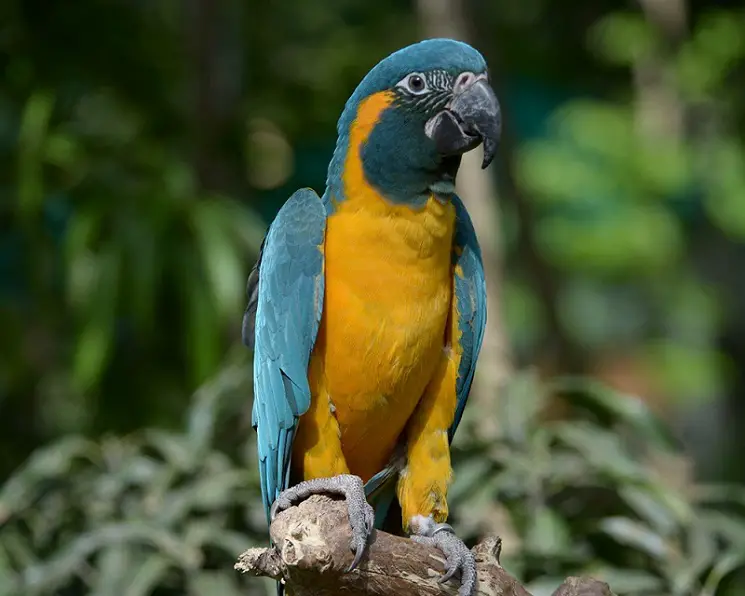
Blue-throated macaws enjoy communicating using sound. When they feel that they are in danger, these birds emit a very loud alarming call and promptly fly off. These birds are also known to converse with each other using quiet caws, as well. Studies have shown that parent blue-throated macaws give out light caws of encouragement from their parents perched nearby. For attracting mates, blue-throated macaws also use acoustic communication, tactile communication, and different tones of sounds.
Food and Eating Habits
Video Source
Embed: <iframe width=”480″ height=”360″ src=”https://www.youtube.com/embed/LE4R02IXs9Q” frameborder=”0″ allow=”accelerometer; autoplay; encrypted-media; gyroscope; picture-in-picture” allowfullscreen></iframe>
Blue-throated macaws do not eat seeds and nuts as much as other macaw species do. Instead, these blue-throated birds eat fruit from large palms. They prefer eating the mesocarp from nearly ripe and ripe fruit. They also love drinking from the liquid from very immature fruit.
Pet blue-throated macaws must be given a pellet blend or a seed mix on a daily basis. They can also be fed with any nutritious foods that you enjoy, especially fruits, vegetables, and chicken meat.
Breeding and Reproduction
Like other blue-throated macaws, they mate for life and are monogamous creatures. Unfortunately, it has not been known if these birds will look for a different partner if their original mate died.
Blue-throated macaws breed once a year if the environmental conditions allow. However, if the nestlings or the eggs are lost, the breeding couple might produce a second clutch of eggs within the same season. There are two periods of breeding for these birds. The first ones breed from August to November, while the other batch breed from November to March.
The blue-throated macaw females lay one to three eggs per clutch and incubate for 26 days. These babies have the weight of at least 18 grams upon hatching. These nestlings fledge at 13 to 14 weeks, but they still stay with their parents for a full year. Blue-throated macaws will also become sexually mature at about 5 years.
Before fertilization occurs, a mating pair of blue-throated macaws must find a suitable nest. If a nest site cannot be found, the pair of birds may excavate their own nest. While deciduous trees can be used, dead palms are easier for them to use for their babies’ nest. Prospective parents also experience fighting for nest sites and competing with other nesting species of macaw.
When the female blue-throated macaws lay their eggs, they spend time in incubating them until they hatch. During incubation, the males hunt food and give them to their partners. Once the eggs have hatched, the parents have a caring instinct that takes time to feed their nestlings.
Common Health Problems
To keep various forms of illnesses at bay, blue-throated macaws must have regular visits to a trusted vet, fed a healthy diet, and exercise regularly. But, like other birds, here are some ailments blue-throated macaws can suffer from:
- Lipomas
- Feather picking
- Tail feathers chewing
- Psittacosis
- Proventricular Dilation Disease
- Infections
- Allergies
- Heavy Metal Poisoning
- Kidney Disease
- Gout
- Papillomas
Predation
Video Source
Embed: <iframe width=”640″ height=”360″ src=”https://www.youtube.com/embed/ofEDEjj8Wxg” frameborder=”0″ allow=”accelerometer; autoplay; encrypted-media; gyroscope; picture-in-picture” allowfullscreen></iframe>
Blue-throated macaws are equipped with cautious awareness, which prevents nest predation in the wild. Parent macaws make it a habit to perch outside their nest, observe their surroundings, and guard their nest against predators. When they return from foraging, these birds approach the nest gradually after they have meticulously checked out the safety of the surroundings. While one parent enters the nest to give the nestlings their meals, the other parent will stand their ground near the nest to protect their family.
Matured blue-throated macaws can be preyed upon by coati, brown capuchin monkeys, southern Caracas, great horned owls, and tayras. On the other hand, the young ones are often preyed upon by crane hawks and toco toucans.
Environment and Housing
For housing, the blue-throated macaws must be provided with a spacious and large cage that one can afford. Because of their very wide wingspan, at 3 feet, it is recommended that these birds be provided a bird room, an outdoor aviary, or a very spacious cage. In order to survive, the blue-throated macaws need to have enough room to move freely.
The minimum housing dimensions must be 5 feet by 5 feet by 8 feet. The cage should also be built with strong wiring. Owners must also provide them with perches, chewable toys, fruit branches, and regular branches for their enrichment and leisure. For their exercise needs, the bird must at least be given the freedom to fly at least 2 hours a day.
Fun Facts about the Blue-throated Macaw
- While they are still young, babies initially have black eyes, which will turn grey, then white while they are one to three years old. As they mature, these turn yellow and will turn golden when they fully mature.
- Blue-throated macaws look very similar to blue and gold macaws.
- The species of blue-throated macaws were unknown to aviculture until the 1970s.
- Blue-throated macaws are monogamous, which means that when they bond, they bond for life.
- In the wild, blue-throated macaws often flock to mountains of clay known as “macaw licks.”
- When they are disturbed, blue-throated macaws screech loudly and fly overhead in circles.
- Blue-throated macaws are very messy eaters, and they have incredibly strong beaks.
- When in flight, blue-throated macaws can go as fast as 56 kilometers per hour.
Where Can You Get a Pet Blue-throated Macaw?
Blue-throated macaws are the rarest of the species of macaw, in terms of availability in the wild. Because of their rarity, these birds are very expensive as quite difficult to acquire. These species are highly sought after, but it is illegal to take species from the wild, and pets can only be acquired from breeders.
How to Care for a Pet Blue-throated Macaw?
Video Source
Embed: <iframe width=”640″ height=”360″ src=”https://www.youtube.com/embed/0ih82WgU-vE” frameborder=”0″ allow=”accelerometer; autoplay; encrypted-media; gyroscope; picture-in-picture” allowfullscreen></iframe>
In caring for a pet blue-throated macaw, their keepers must ensure that their living conditions are ideal and that they are well-fed. For their overall comfort, the temperatures in their enclosures must not go lower than 10 degrees Celsius or 50 degrees Fahrenheit.
These blue-throated macaws are very sociable, and they commit to this behavior, even when kept as pets. They love being in the company of humans and other birds. These macaws are very self-sufficient, and they can keep themselves entertained for long periods.
For their hygiene, bathe them every day either through misting or through a birdbath. Make sure that the water is at room temperature so that the birds will not feel too cold. Clip their beaks and nails every two months. Additionally, clean their food dishes and water dishes regularly.
Frequently Asked Questions
Is the blue-throated macaw extinct?
The blue-throated macaw has a very small population and is on the verge of extinction in the wild. It is critically endangered in the IUCN Red List.
How many blue-throated macaws exist in the world?
According to the last assessment done on August 7, 2018, there are about 50 to 254 blue-throated macaws left in the wild.
How much do blue-throated macaws cost?
The prices of the blue-throated macaws are estimated to be at $2,000 or even more.
Can Blue-throated Macaws talk?
Blue-throated Macaws can be very vocal, depending on the situation. They sometimes mimic words and caw, but when they are startled, these birds can produce loud sounds.
Are there still blue-throated macaws?
Yes. Blue macaws are still existing, though their numbers are drastically smaller.
Where do blue-throated macaws live?
Blue-throated macaws live in Northern Bolivia.


